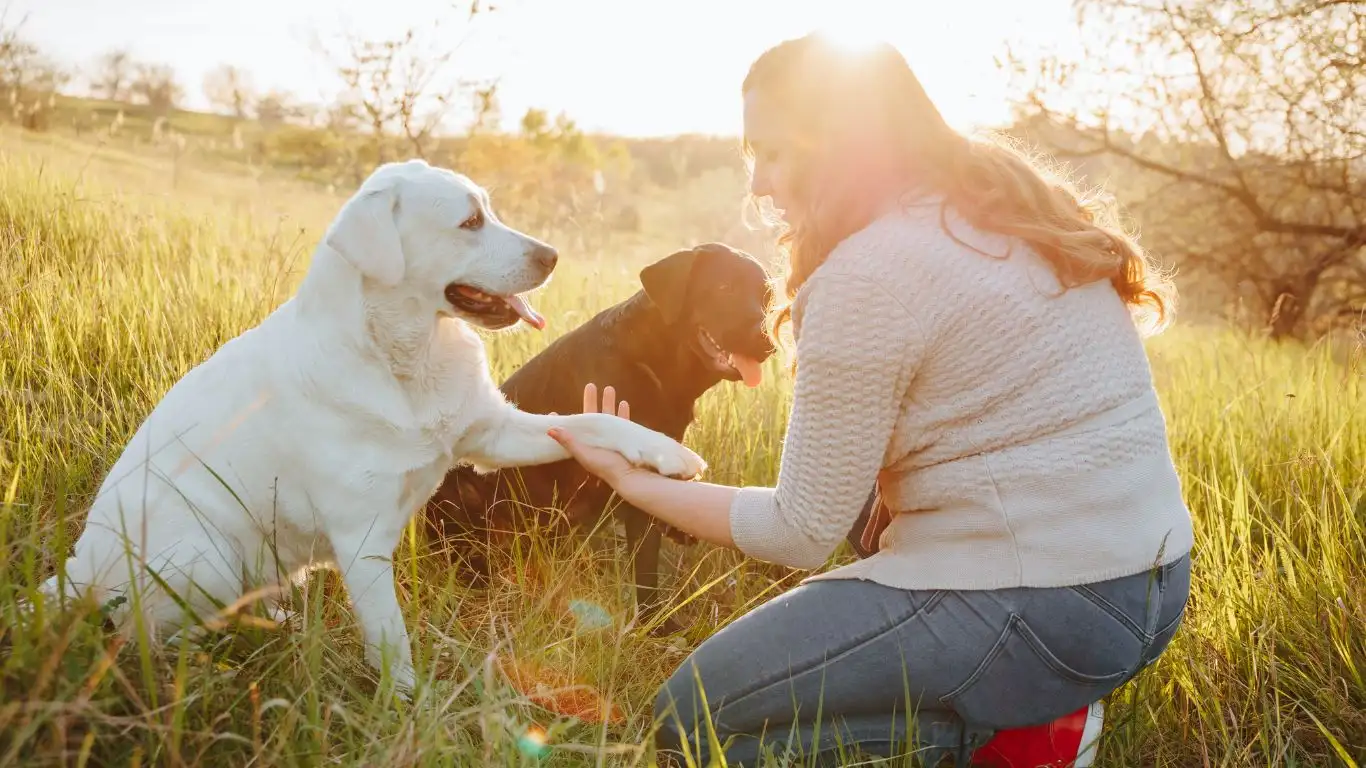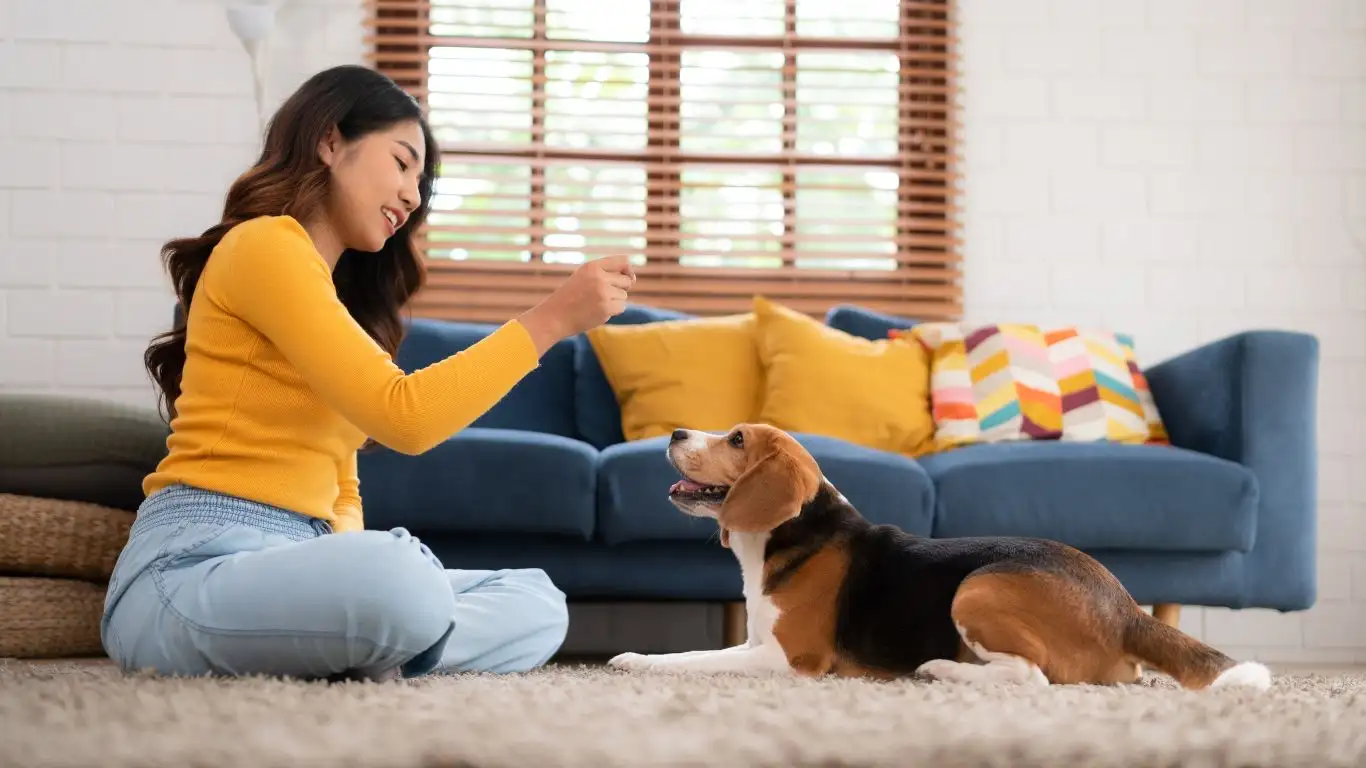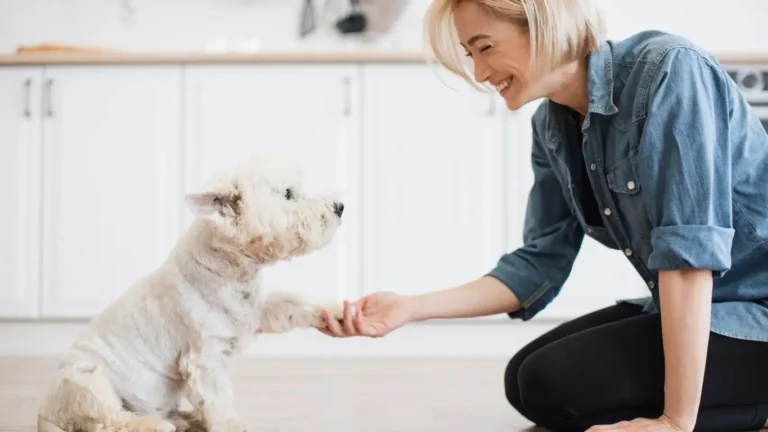Proven Strategies on How to Train a Dog to Stop Whining for Attention Fast
If you’re like me, you’ve probably seen dogs at some point whining for attention—whether it’s because they’re bored, anxious, or just want to interact with their humans. As a Canine-Assisted Therapy Trainer, I’ve encountered many pet parents frustrated with their dog’s constant attention-seeking behaviors. It’s one of the most common issues I hear about in my sessions. But the good news is that it’s entirely possible to train your dog to stop whining for attention—and I’m here to walk you through it! In this guide, I’ll share the techniques I use to help dogs and their owners develop healthier communication habits. Let’s dive into understanding why dogs whine and how you can train your dog to stop whining for attention.
Why Do Dogs Whine for Attention?

Before we dive into the training techniques, it’s essential to understand why dogs whine for attention in the first place. As a Canine-Assisted Therapy Trainer, one thing I always emphasize is that behavior is communication. When dogs whine, they are typically trying to tell us something. It could be that they want to go outside, need food or water, or simply crave some love and companionship. However, when whining becomes excessive, it’s usually because they’ve learned that whining gets them the attention they desire. So, understanding this behavior is the first step to curbing it.
Let’s break it down further:
- Seeking Attention: Dogs love being the center of attention. They quickly learn that whining is an effective way to get it from their humans. If you give in and respond to the whining, even if it’s just by looking at them, you’re reinforcing the behavior.
- Boredom: If a dog isn’t mentally or physically stimulated, they may resort to whining as a way to express their frustration or boredom. Dogs need regular exercise and mental enrichment.
- Anxiety or Stress: Sometimes, dogs whine when they are feeling anxious or stressed. It could be triggered by separation anxiety, unfamiliar environments, or even loud noises. In such cases, their whining is more about distress than seeking attention.
Understanding Your Dog’s Needs and Emotions

Before you can effectively train your dog to stop whining, you must first understand their needs and emotions. As someone who has worked closely with dogs for many years, I’ve learned that dogs are not just whining for no reason. Every action, even something as seemingly trivial as whining, has a cause. If we take the time to understand the underlying reason, we can develop a more targeted approach to training.
Is it Attention-Seeking or Something Else?
It’s easy to assume that all whining is simply a way for a dog to get attention, but sometimes the reasons can be more complex. I always recommend taking a moment to assess whether your dog’s whining is driven by anxiety, boredom, or something else entirely. The more you know about your dog’s emotional state, the better you can address the root cause. Here’s how to determine whether your dog is just seeking attention:
- Is it constant or periodic? Dogs that whine occasionally might just be asking for attention, while those that whine incessantly may be experiencing a deeper emotional issue.
- What happens when you ignore them? If your dog stops whining after a while when ignored, it’s likely an attention-seeking behavior. However, if they continue or show signs of distress, it could be anxiety or discomfort.
- Does the whining happen in specific situations? If the whining occurs in certain contexts—like when you’re about to leave the house or when there’s a loud noise outside—it’s probably linked to anxiety or fear.
How to Train a Dog to Stop Whining for Attention

Now that we have a better understanding of why your dog is whining, it’s time to focus on how you can train them to stop. The key is consistency and patience. Over the years, I’ve helped many pet parents successfully reduce their dogs’ attention-seeking whining by using a combination of positive reinforcement and redirection techniques. Below are some proven methods I use in my training sessions.
1. Ignore the Whining (But Be Consistent!)
The first and most important step is to stop reinforcing the whining behavior. If your dog is whining for attention and you give in—even if it’s just to quiet them for a moment—they learn that whining gets them what they want. Instead, make a commitment to ignore the whining completely. Don’t give your dog eye contact, talk to them, or touch them. I know it can be tough, especially when those sad puppy eyes are staring at you, but this step is crucial for breaking the cycle of attention-seeking behavior.
Tip from experience: It’s essential to be consistent here. If you only ignore the whining sometimes, your dog will become confused and may try even harder to get your attention. Over time, they’ll realize that whining doesn’t work, and the behavior will naturally decrease.
2. Redirect Their Energy
When your dog starts whining, redirect their attention to something else. This could be a toy, a puzzle, or a command like “sit” or “down.” The goal is to shift their focus away from the whining and onto a more appropriate behavior. Dogs thrive on structure and routine, and by consistently redirecting their energy, you are teaching them more appropriate ways to ask for attention.
For instance, when your dog whines, calmly direct them to a toy they enjoy or ask them to perform a trick like “sit.” Once they comply, reward them with praise or a treat. This teaches them that quiet and calm behavior is the way to get your attention, not whining.
3. Reward Quiet Behavior
Another important technique is to reward your dog when they are quiet. By doing this, you’re reinforcing the behavior you want to see. When your dog is calm and quiet, make sure to give them plenty of positive reinforcement—whether that’s verbal praise, a belly rub, or a tasty treat. This creates a positive association with being calm and quiet, rather than whining.
In conclusion, training your dog to stop whining for attention requires a combination of patience, consistency, and understanding. Remember, it’s not about punishing your dog but about teaching them more appropriate ways to communicate their needs. Stay tuned for more tips in the next part of this guide!
Building a Routine to Prevent Attention-Seeking Whining

Consistency is key when it comes to training your dog to stop whining for attention. A well-established routine not only helps your dog feel more secure but also reduces the likelihood of them resorting to whining as a form of communication. Dogs are creatures of habit, and when they know what to expect, they’re less likely to seek attention through unwanted behaviors.
Setting Clear Expectations
One of the first things I recommend to pet owners is creating a daily routine for their dogs. This includes set times for walks, meals, playtime, and training sessions. The more predictable your dog’s day is, the less anxious they will feel, and this can help reduce whining.
For example, if your dog gets used to having their dinner at 6:00 p.m. every night, they’ll start to anticipate it. They won’t whine at 5:00 p.m. because they know food is coming soon. Similarly, if you establish a routine of quiet time during certain parts of the day, your dog will understand that it’s time to relax and won’t feel the need to whine for attention.
How to Implement a Structured Routine
Creating a routine doesn’t have to be complicated! Here’s a simple example of a daily schedule you could follow:
- Morning Walk/Exercise (7:00 a.m.) – Start the day by getting your dog’s energy out with a walk or some playtime. Physical exercise is crucial for a dog’s overall well-being and will help curb any pent-up energy that might result in whining later.
- Training Session (8:00 a.m.) – Spend 10-15 minutes practicing obedience commands or tricks. This not only helps with training but also provides mental stimulation, which can prevent boredom and excessive whining.
- Quiet Time (10:00 a.m.) – After some active time, allow your dog to relax in a designated quiet area, like their crate or a cozy corner. This teaches your dog that there are times when attention isn’t available and encourages them to settle down.
- Afternoon Play (2:00 p.m.) – Engage in interactive play or take your dog on another walk. Regular exercise throughout the day reduces the chances of your dog seeking attention through whining.
- Evening Routine (6:00 p.m.) – Meals, followed by some downtime, reinforcing the calm and quiet behavior learned earlier.
By creating a structure like this, you help your dog learn when it’s time to be active and when it’s time to relax. This not only minimizes unwanted behaviors but also gives your dog a sense of security, knowing what comes next in their day.
Addressing Separation Anxiety in Dogs

Another important factor to consider when dealing with whining for attention is separation anxiety. Many dogs whine because they are anxious when left alone. As a Canine-Assisted Therapy Trainer, I’ve worked with several dogs who displayed this behavior, and it’s often heartbreaking for both the dog and the owner. Separation anxiety can manifest in many ways, including excessive whining, destructive behavior, and even accidents in the house.
While it can be tough to see your dog struggle, there are ways to help ease their anxiety and reduce their need to whine when left alone.
Identifying Separation Anxiety
If your dog tends to whine as soon as you pick up your keys or prepare to leave, it’s likely that separation anxiety is the cause. Dogs with separation anxiety may also engage in other anxious behaviors, such as:
- Destructive chewing or scratching: This is often seen around doors, windows, or furniture, as the dog tries to get to you.
- Excessive drooling: Some dogs may begin to salivate excessively when they sense you’re about to leave.
- Attempts to escape: Some dogs with severe anxiety will try to escape from their crates or through windows and doors.
Understanding the signs of separation anxiety will help you take the necessary steps to address the behavior appropriately. It’s important to note that this type of anxiety isn’t something that can be corrected overnight, but with patience and training, your dog can learn to feel more secure when left alone.
How to Help Your Dog with Separation Anxiety
When working with dogs who have separation anxiety, I focus on creating positive associations with being alone. Here are a few techniques that have been particularly effective in my sessions:
- Gradual Desensitization: Start by leaving your dog alone for short periods and gradually increase the time. The key is to not make a big deal out of leaving or returning. Keep your departures and arrivals low-key to avoid causing additional stress.
- Provide Mental Stimulation: Give your dog something to do while you’re gone, such as a puzzle toy filled with treats or a long-lasting chew. This can help distract them and prevent boredom-induced whining.
- Comforting Environment: Make sure your dog has a comfortable space to relax in, such as a crate or a cozy bed. This can help them feel secure when you’re not around.
Over time, your dog will learn that being alone doesn’t have to be a scary experience, and their need to whine for attention will likely decrease.
Using Positive Reinforcement to Curb Whining

Positive reinforcement is a powerful tool in any dog training session, and it’s particularly effective when addressing whining for attention. As mentioned earlier, rewarding calm and quiet behavior is crucial, but let’s dive deeper into how you can use rewards to reinforce good habits and discourage whining.
How to Use Rewards Effectively
Rewarding your dog for being quiet may seem like a simple solution, but it’s incredibly effective when done correctly. Here’s how to ensure you’re using positive reinforcement to its full potential:
- Timing is Everything: The reward must come immediately after the desired behavior. If your dog is quiet for a few seconds, reward them right away so they can make the connection.
- Use High-Value Rewards: If your dog is particularly stubborn about their whining, try using something more exciting than usual—a special treat or a favorite toy that’s reserved just for training sessions.
- Keep It Consistent: Consistency is the backbone of positive reinforcement. If you’re inconsistent with your rewards, your dog might not understand what behavior is being reinforced.
By focusing on rewarding the behaviors you want to see, you’ll be able to gradually phase out the unwanted whining behavior and replace it with calm, positive actions.
Understanding and Managing Setbacks in Training

As much as we’d love training to be a straightforward process, let’s be honest—there will be setbacks. Whether it’s a particularly stressful day for your dog, or perhaps they’re testing their boundaries, setbacks are a normal part of the journey when training a dog to stop whining for attention. But don’t get discouraged—this doesn’t mean all your hard work is undone. It just means that patience and consistency need to be dialed up a notch.
Why Setbacks Happen
Even the best-trained dogs will occasionally slip up. Life happens—there may be new changes in the household, a disruption in their routine, or even stress from an unfamiliar situation that triggers a temporary increase in whining. From my experience, it’s important to understand that setbacks are part of the learning process. It’s not about erasing the behavior completely in one day, but about making gradual improvements.
If your dog begins to whine again after weeks of calm behavior, don’t panic. Instead, consider these possible reasons:
- Stress or Changes in Routine: Dogs are creatures of habit, and any major changes—like a new pet, moving to a new house, or even a change in your schedule—can cause stress that might trigger whining.
- Health Issues: Sometimes, dogs whine because they’re in pain or discomfort. If your dog starts whining more than usual, it’s always a good idea to rule out any potential health concerns by visiting the vet.
- Inconsistent Training: If you’ve been inconsistent with your training or allowing your dog to get away with whining here and there, they may start testing the limits again.
Understanding why setbacks happen can help you address them with a clearer head, rather than simply getting frustrated. Remember, this is a marathon, not a sprint!
How to Handle Setbacks with Patience
When setbacks occur, it’s important not to lose your cool or feel like you’ve failed. Instead, use these moments to reaffirm your training techniques and keep the momentum going. Here are a few strategies I use with clients when they face setbacks:
- Return to Basics: If your dog starts whining again, it may be time to go back to square one. Start with short training sessions, reinforcing the basics of ignoring the whining, redirecting, and rewarding calm behavior.
- Adjust the Routine: If your dog’s schedule has changed, try to reintroduce a more structured routine to ease their stress. A solid routine provides dogs with a sense of security, so a slight tweak might help them settle back down.
- Stay Calm and Consistent: Dogs can pick up on their owners’ stress. If you stay calm and consistent in your approach, your dog will learn to mirror that calmness. Just remember, patience is key!
By continuing to focus on positive reinforcement and remaining consistent, your dog will likely return to their calm behavior once the situation settles down. Don’t be afraid to lean on your training tools—whether it’s calming toys, treats, or even time-outs in their quiet space. This will help them regain that sense of peace and routine.
Additional Tips for Managing Your Dog’s Attention-Seeking Behavior

Along with the basic techniques we’ve discussed, there are a few additional tips and tricks that can be incredibly useful for managing your dog’s attention-seeking behavior. These tools can be a game-changer in making sure your dog stays calm and content without excessive whining.
1. Provide Mental Stimulation
Dogs need mental stimulation just as much as physical exercise. If your dog is constantly whining, it might be a sign they are bored or under-stimulated. Incorporating puzzle toys, obedience games, or even scent work into your daily routine can give them the mental workout they need.
For example, I often use treat-dispensing toys that require the dog to think and work to get their reward. This keeps them occupied and mentally engaged, reducing the likelihood that they’ll resort to whining to pass the time.
2. Keep Your Dog Socially Stimulated
Social interaction is another critical factor in keeping your dog from getting too lonely or frustrated. Regular playdates with other dogs or even taking them to dog-friendly parks or events can help satisfy their social needs. A well-socialized dog tends to be a calmer and more content dog, which can significantly reduce whining for attention.
3. Use Calming Products
For dogs who are particularly anxious and prone to whining, calming products like anxiety wraps, pheromone diffusers, or calming collars can work wonders. These products are designed to reduce anxiety by mimicking the calming effect of a mother dog’s scent or by applying gentle pressure, which can help soothe your dog in stressful situations.
When to Seek Professional Help
While most cases of attention-seeking whining can be handled with training, there are instances where professional help is necessary. If you’ve tried all the techniques and nothing seems to work, it may be time to consult a certified dog trainer or a behaviorist. In some cases, excessive whining may be a symptom of a deeper issue, such as anxiety, trauma, or even a medical condition.
Working with a professional will allow you to get a tailored plan that addresses your dog’s specific needs. As a Canine-Assisted Therapy Trainer, I work with clients who have dogs struggling with complex behavioral issues, and I can tell you that seeking professional guidance can make a world of difference in achieving lasting results.
Resources for Further Reading:
- American Kennel Club – A great resource for dog owners, with plenty of information on dog behavior and training.
- PetMD – Offers insights into both behavioral and health-related concerns for dogs.
- National Institutes of Health – Read up on how anxiety and stress affect your dog’s behavior.
By understanding the root cause of your dog’s behavior and being proactive with consistent training, you’ll be able to help them feel more secure and reduce the amount of whining for attention. It’s a process that takes time, but with patience and dedication, you’ll see results. Remember, every dog is different, so don’t be afraid to adjust the approach to fit their individual personality and needs!
Disclaimer
The information provided in this article is intended for educational purposes only. Always consult with a professional veterinarian or a certified dog trainer for advice tailored to your dog’s specific needs and health conditions. No two dogs are the same, and the strategies discussed may not work for every dog or situation.






